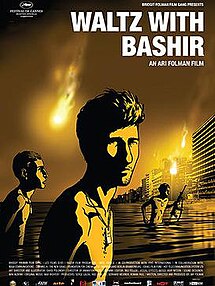 Waltz with Bashir is an award winning animated documentary film made in Israel in 2008. The film is made with a unique style described by Wikipedia as
Waltz with Bashir is an award winning animated documentary film made in Israel in 2008. The film is made with a unique style described by Wikipedia asa combination of Adobe Flash cutouts and classic animation. Each drawing was sliced into hundreds of pieces which were moved in relation to one another, thus creating the illusion of movement... From there 2,300 original illustrations were drawn based on the storyboard, which together formed the actual film scenes using Flash animation, classic animation, and 3D technologies.
The film explores the troubled memory of an Israeli soldier who was a witness to the famous 1982 Sabra and Shatilla massacre of Palestinian and Lebanese civilians. According to Wikipedia, the Israeli Army was surrounding these refugee camps in poor neighborhoods in West Beirut and specifically allowed the Lebanese Christian Militia to enter the camps and kill civilians. The number of casualties is disputed, some say as low as 350, others ten times higher, 3500. An investigation by the Israeli government found Ariel Sharon personally responsible and he resigned as head of the defense ministry. An independent commission found that Israel's invasion of Lebanon in 1982 violated international law. The invasion was condemned at the time by the UN Security Council. At the time the United States told Israel not to occupy the area of Lebanon where these camps were located and promised the Muslims of West Beirut, including Palestinian refugees in the camps, that they would be safe.
At the time, and still today, there were many Palestinian refugees in Lebanon as a result of the 1948 war that established the state of Israel and other conflicts. Another group in Lebanon is the Maronite Christians, sometimes closely tied to Israel. Days before the massacre their leader, Bachir Gemayel, was assassinated by an agent of the government of Syria -- not connected to the Palestinians who were in the camps, although Syria supported the Palestinians.
The Maronite soldiers were brought to the camps by the Israelis, sent into the camps, and provided with support at night from flares shot over the camps by the Israeli army. (A focus in the film.) "According to a Dutch nurse, the camp was as bright as 'a sports stadium during a football game.'" The Israeli army guarded the exits from the camps and allowed no one to leave while the massacre was taking place.
In 1982 the United Nations General Assembly voted to identify the massacre as a "genocide."

1 comment:
Interesting that Sharon resigned from his position, but later became the Prime Minister of Israel...
I was able to watch the film at The Little Theater last winter. I was touched by it and learned a lot through it: I didn't know about the massacres before, and got some insight on what Israeli soldiers go through. One criticism that I had: the film makes it seem like no one was able to do anything against it; the massacre was out of everyone's hands and no one could prevent it.
Besides that, I liked how the narrator realized the reality of the situation and didn't glorify Israel's position.
Post a Comment